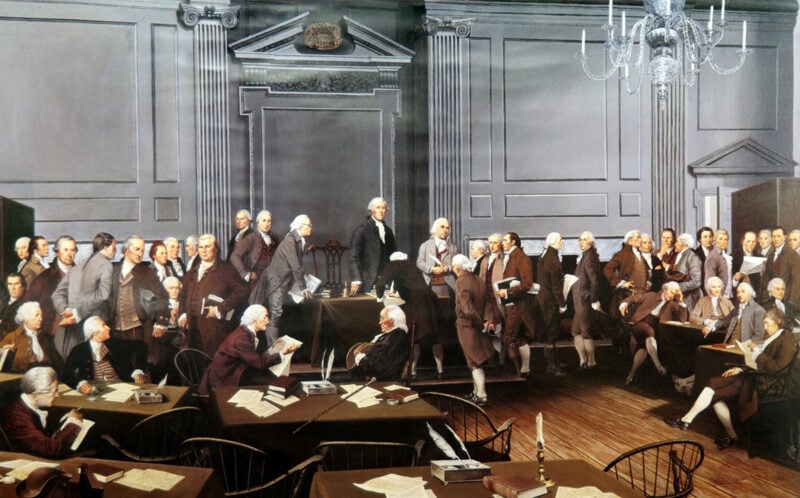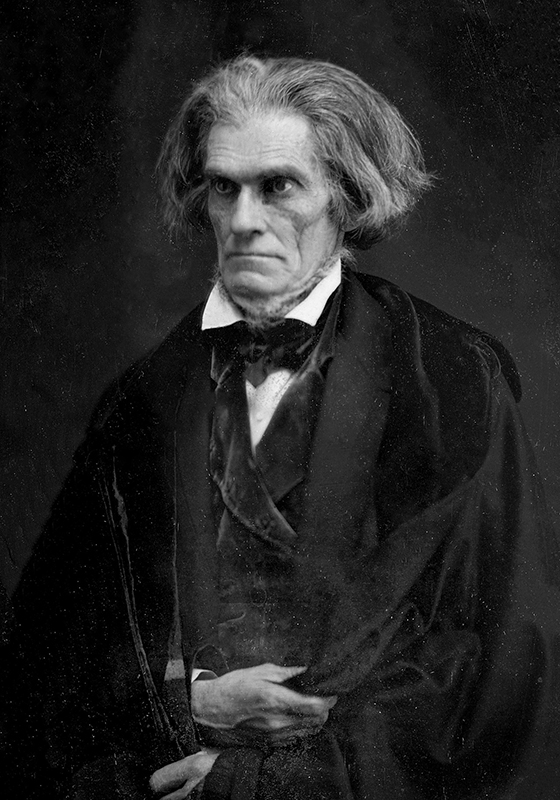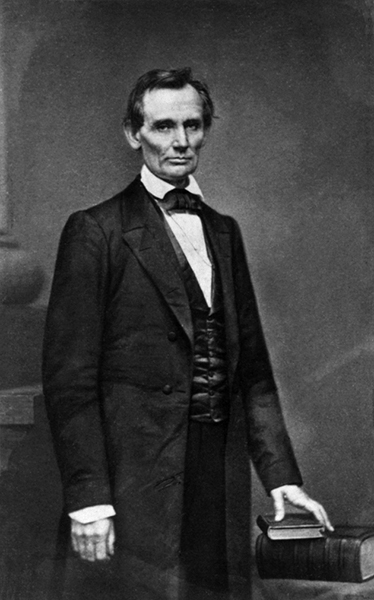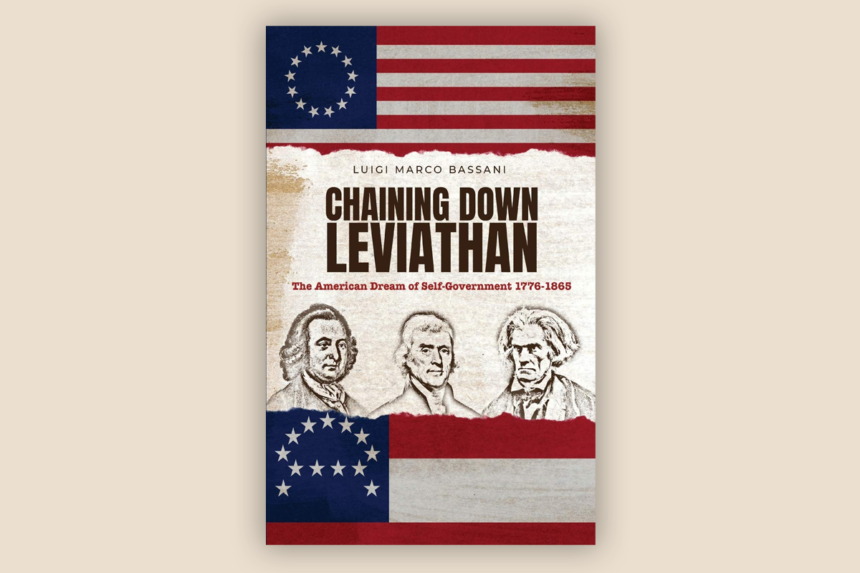by Luigi Marco Bassani
Abbeville Institute Press
380 pp., $19.95
European observers of the American scene have often offered valuable insights into American culture and politics. Marco Bassani has long been a student of American history and the European nation-state’s rise since the 17th century. Both of these areas of expertise are brought into play in this analysis of America’s momentous transformation from a republic of sovereign states to a sovereign, consolidated nation in the European mold. Until fairly recently, the consensus among American historians was that this shift was somehow inherent in the trajectory of the Enlightenment project. This assumption, insists Bassani, is itself a part of the “myth” of the modern state.
In fact, to employ the adjective “modern” to the concept of the state is a redundancy. The state is a modern construct. Hobbes and Bodin, and after them Kant and Hegel, were its inventors; though certainly the absolutist monarchs had already laid much of the groundwork that enabled its emergence. Anthropologists and historians of the ancient world typically use, or misuse, the term “state” to describe the various forms of premodern governance as if they were primitive forms of the same concept. On the contrary, the state’s inventors were radical in their designs. They conceived of a form of sovereignty unknown to the world before the 17th century, one that was “eternal, inescapable and ubiquitous,” with a monopoly on violence that eliminated all intermediate claims to power and authority.
In keeping with the movement toward ruthless centralization—and in part abetting it—impersonal bureaucracies emerged, first in France, and spread rapidly across Western Europe. Advocates of the state have always regarded this movement toward centralization as a quest for political unity, one that can tolerate no competitors. “Otherness,” notes Bassani, “is not an option.” Today, to veil this totalitarian reality, the caretakers of the state encourage endless prattle about the joys of cultural diversity, though even that diversity is severely curtailed if it in any way threatens their monopoly on power.
Contrary to what is commonly taught in our universities, the American founders, when they gathered in Philadelphia in 1787 for the Constitutional Convention, did not (with the exception of Alexander Hamilton and his cadre of nationalists) see the new federation as “a stage” leading to the adoption of the state system, Bassani writes. In the years prior to the Revolution, each of the colonies had understood itself to be one of many “independent communities” under the authority of the Crown, which was “the guarantor of the various autonomies.” This conviction was predominant in the crafting of the Articles of Confederation and the debates over the Constitution, which replaced the authority of the Crown but gave no powers to the central government not authorized by the states.

above: The Signing of the United States Constitution by Louis S. Glanzman, 1987 (commissioned by the PA, DE, NJ State Societies, Daughters of the American Revolution, Independence National Historical Park Collection, National Park Service)
In Philadelphia, three factions vied for dominance: the nationalists, the centrists, and those who wished to give even greater powers to the states—the last group consisting of those who had championed the Articles of Confederation. As is well known, the centrists, under the leadership of James Madison, prevailed. The Constitution was a compromise that delicately balanced the distribution of powers. Yet the priority given to the autonomy of the states is evident in the ratification process itself, as well as in the provision for amendments by a two-thirds majority of the states. The notion, still widely shared, that the states at the time of ratification entered into a compact from which they could not withdraw, is, as Bassani argues convincingly, simply untenable.
The great struggle between the Federalists and the Anti-Federalists, which began during the Convention and continued to be fiercely waged during the ratification process, lies at the heart of Bassani’s book. He takes pains to show that well into the 20th century our historical understanding of the two groups and their aims has been dominated by a Federalist bias. Perhaps the most important reason for this is that the often pseudonymous writings of the Anti-Federalists were not well-known or understood in their full context by later historians. Their antagonists, by contrast, decisively gained control of the narrative by the early publication of The Federalist, which Bassani regards as in essence a work of propaganda that gave its supporters “an unprecedented historiographical advantage.”
Almost from the outset, Bassani notes, The Federalist “was viewed as the authentic interpretation of the Constitution,” when in fact the original objective of the volume was a political one: to “convince New York voters to elect delegates to the state ratification convention.” New York was, of course, Hamilton’s home state and had been “a bastion of resistance to the constitutional project.” But once the compromise was reached, he and his followers saw their main chance in seizing the interpretive high ground. Hence the term “federalist” came increasingly to be associated with the idea that a “strong federal government would be the best guarantee of freedom in America.”
Of course, the Anti-Federalists had their own bastions of support, especially in states such as North Carolina and Georgia. To appease them and achieve ratification, the Federalists were forced to agree to the Bill of Rights, a concession to which Hamilton and Madison were initially opposed. The first test of those amendments was the Alien and Sedition Acts of 1798, passed by a Congress dominated by Federalists during the administration of John Adams. The Acts unleashed a firestorm of opposition, primarily from Anti-Federalists like Patrick Henry, but also from Thomas Jefferson.
Jefferson had become increasingly allied with the Anti-Federalists and secretly penned the Kentucky Resolutions (1798) defending the right of the states to reject any law promulgated by the federal government that trespassed upon fundamental liberties, especially the First Amendment right to free expression. The language of the Alien and Sedition Acts was, in fact, wide open to invidious interpretation. It gave the federal government power to imprison any individual who engaged in “defaming the government” or in “bringing it into disrepute.” Jefferson, who was vice president at the time, saw the Acts both as a threat to liberty and as directly intended to stifle the opposition which he represented: the Democratic-Republican Party, which was by then the institutional voice of anti-federalism. One of the great virtues of Bassani’s text is that he insists vigorously upon the importance of the Kentucky Resolutions as the “fountainhead of states’ rights doctrine,” anticipating the later work of John C. Calhoun, who brought that doctrine to its fruition.
While Jefferson argued for the “natural right” of each state to declare the “illegitimacy of an act of Congress,” Bassani follows historian Charles M. Wiltse who wrote that the resolutions, implicitly at least, “completed the transformation of the natural rights dogma into the far more powerful doctrine of States rights.” From Calhoun’s perspective, the Constitution does not authorize the authority of a nebulous mass of individuals sans habitation, something that can only lead, as Bassani notes, to a “malaise of representation.” Constitutionally speaking, the people are recognized primarily as inhabitants of their states, and their elected officials represent not individuals as such but the collectivity of each state.
In the Kentucky Resolutions, Jefferson defends the “rights” of the states by an extension of the Lockean paradigm of individual natural rights, an argument that falls short of a full defense of state sovereignty—a term that he does not employ. Calhoun, while building on the Jeffersonian thesis, abandons Lockean theory and its concomitant assumption of a “state of nature” which precedes social and political communities. In Locke’s view, the rights of the individual are inherent and “inalienable,” not established by a prior political or social order. Calhoun counters this view with the assertion that individuals are “rights bearing” only by virtue of a political order that grants such rights. In the American constitutional system, such rights flow out of the compact between the states which gave birth to the Constitution.
For both Jefferson and Calhoun, to transform the United States into a unified nation-state would lead inevitably to the destruction of the political sovereignty of the individual states, and would rob the citizens of those states of any enduring protection against federal tyranny. “Only power,” Calhoun wrote, “can effectively resist power.”

above: John C. Calhoun, photographed by Mathew Brady in 1849, shortly before his death
As Calhoun asserts throughout his work, and especially in the posthumously published Disquisition on Government (1850), each state is an original and sovereign political community; the states were already sovereign when they entered into a compact to form a federation, but while they agreed on certain points to limit that sovereignty, they did not yield it up to some greater federal sovereignty. Strictly speaking, the federal government has no sovereignty other than that granted provisionally by the states.
Abraham Lincoln was, according to Bassani, the “one who embodied the decisive project of transplanting the modern state into America.” The “cult of the nation” was finally and definitively personified in Lincoln, but among those who laid the groundwork for the Lincolnian project was Francis Lieber, a dissident Prussian jurist who immigrated to the U.S. in 1827. In a series of influential texts, he defended the European idea of the state as a “jural” entity—that is, as Lieber stated, a “conditio sine qua non [whose] absolute necessity constitutes the ground on which is founded what is called sovereignty … the self-sufficient power that derives its vital energy from no other.”
While it would not be quite correct to suggest that Lincoln was a disciple of Lieber’s thought, one can recognize in the German’s “self-sufficient power” a foreshadowing of Lincoln’s “more perfect Union.” As Bassani notes, as early as his First Inaugural Address in 1861, Lincoln “made it clear to the States that they were no more than institutional constituents of a true nation.” In that same address he asserted that the Union was “perpetual.”
It is not without a certain grim irony that Calhoun himself may have inadvertently helped to clear a path to the Lincolnian idea of Union—this, at least, is one of Bassani’s more interesting arguments. In the early 1830s, Calhoun had effectively demolished what Bassani calls the “confused Madisonian doctrine of ‘divided sovereignty.’” Calhoun insisted that there could be no middle ground, that sovereignty must reside either in the states or in the federal government. He was confident that the argument in favor of the federal sovereignty could not be sustained.
But the historical drift had begun to favor the nationalist solution well before Calhoun’s death, and by eliminating the possibility of any middle ground, he helped open the door to the Lincolnian solution, though it must be recognized that Lincoln did not make his case on strictly intellectual grounds (which were deficient) but on sentimental, moral, and even religious appeals to “the bonds of our affection” and the “mystic chords of memory.”

above: Abraham Lincoln, photographed by Mathew Brady in 1860, taken the day of the Cooper Union speech
At Gettysburg in 1863, Lincoln announced a “new birth of freedom.” It would perhaps be more accurate to say that he inaugurated a new era of “positive liberty,” one that some have seen as a second American Revolution that necessitated a radically new understanding of the Constitution as an “organic” and thus evolving instrument of social change. The founders’ understanding of the Constitution as a guarantor of “negative” liberties—that is, liberty from the threat of government encroachment—was replaced by the view that the state was the true protector of the people against bad actors in the social order, especially those who would deprive the people of equality.
Bassani endorses the view of George Fletcher in Our Secret Constitution (2001) that, as a result of the Lincolnian transformation (which culminated in the 14th Amendment), “Americans now understood that any generation could challenge and enlarge a previous generation’s Constitution without violating the original charter.”
But violate that charter is precisely what Lincoln did, for he placed the sanctity of Union above the Constitution, a conviction in complete accord with the Unionism of Henry Clay, as expressed in his compromise speech of 1850, and by Daniel Webster in his debate with Robert Hayne. For these men, the Union was something which preceded the Constitution, and, in the admiring words of the current dean of establishment Civil War historians, Eric Foner, was “the paramount end of politics.”
This review hardly does justice to Bassani’s rich assessment of the transformation wrought between 1776 and 1865. At the very least, readers unfamiliar with the role played by the Anti-Federalists in our early political history will find themselves astonished at how much is left out of the standard account of those years.
One may even find oneself appalled to learn that the concept of the state adopted by Father Abraham and foisted upon America by force of arms is little short of idolatry. There is little doubt that our 16th president agreed with Francis Lieber that “the state is a form and faculty of mankind to lead the species towards greater perfection—it is the glory of man.”
